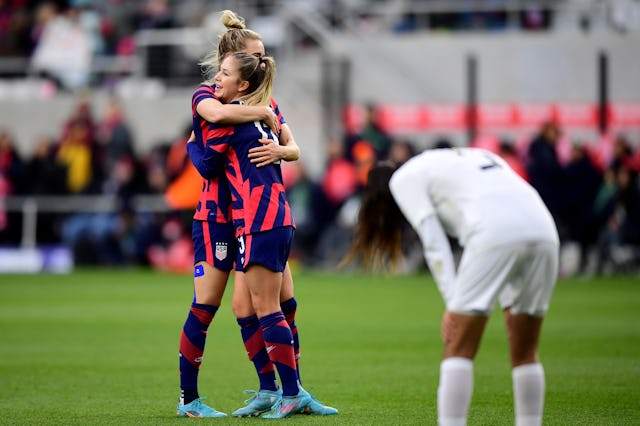U.S. Men’s And Women's National Soccer Teams Reach Historic Agreement For Equal Pay
Both teams will also now have the same childcare benefits.

It’s incredible how much effort it takes to teach grown-ups how to share. But after battling for years, U.S. soccer achieved an historic victory on Tuesday when both the men’s and women’s teams ratified a new collective bargaining agreement (CBA) for equal pay, including an equal split of World Cup bonuses.
“This is a truly historic moment. These agreements have changed the game forever here in the United States and have the potential to change the game around the world,” U.S. Soccer President Cindy Parlow Cone said in a statement from the U.S. Soccer Federation.
“U.S. Soccer and the USWNT and USMNT players have reset their relationship with these new agreements and are leading us forward to an incredibly exciting new phase of mutual growth and collaboration as we continue our mission to become the preeminent sport in the United States,” Parlow Cone continued.
This new rule for pay equity comes on the heels of the February settlement of a gender discrimination lawsuit filed by the USNWT against U.S. Soccer Federation. Filed in 2019, the suit spent years entangled in legal proceedings. This year the U.S. Soccer Federation finally agreed to pay $24 million, to be distributed among the players on the condition that the USWNT ratify this collective bargaining agreement. With the CBA now ratified, USWNST players will be able to apply to receive up to $50,000 each of the settlement monies.
The CBA marks another milestone in players’ battle for equal pay. The equalizing of World Cup bonuses will likely result in a loss of money for the men, and a gain for the women. FIFA sets the prize monies for the World Cup, with the men’s World Cup in Qatar this year totaling $440 million. If the U.S. men’s team makes it to the round of 16, they’ll be paid $13 million. The Women’s World Cup 2023 total, in comparison, is set for $60 million. FIFA defends their discriminatory pay with claims that men’s teams bring in more revenue, but the end result is that the U.S. men often bring in more than the U.S. women for worse performance. The new CBA corrects for this by splitting all the World Cup money equally between the men’s and women’s teams.
Let’s take a moment here to recognize the men who voted to ratify this CBA, fully aware that it will almost certainly mean less money in their pockets.
The women’s team also made concessions, giving up salaried contracts for some of their players and switching to the pay-to-play model the men’s team uses.
The CBA shifts the dynamic between the teams, with both gaining from each other’s success.
“We’re working together,” Nashville SC defender Walker Zimmerman, a member of the U.S. National Soccer Team Players Association leadership team, told ESPN.
“It’s equal,” Zimmerman continued. “We will be their biggest fans. I’m sure they will be our biggest fans, as well."
While the equal split of the World Cup bonuses is dominating the headlines today, the CBA contains a number of other provisions enshrining an equal pay structure, in on-field base and performance pay and commercial revenue sharing. The CBA also spells out provisions for playing and training environments as well as retirement benefits.
The cherry on top, though, has to be this: “During Senior National Team training camps and matches, U.S. Soccer will provide childcare, as it has for the USWNT for more than 25 years.” Male Senior National Team players will now receive the same childcare benefits as the women players.
Equal pay and equal childcare benefits? Other employers better be listening.